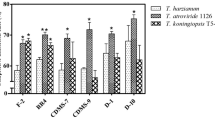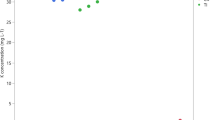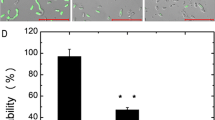Abstract
Fusarium root rot caused by Fusarium solani severely damages the roots of Panax notoginseng (ginseng) seedlings eventually leading in most cases to the total loss of this valuable crop. Soil fumigants are generally better at controlling soil-borne diseases such as F. solani than fungicides which provide unacceptable control. We tested the efficacy of two fumigants allyl isothiocyanate (AITC) and dimethyl disulfide (DMDS) against F. solani in the laboratory. AITC inhibited F. solani mycelial growth completely at a concentration of 1.2 μg/L and significantly reduced CO2 emissions of F. solani. Ultrastructural studies showed that AITC disrupted the cell membrane of F. solani by causing plasmolysis and plasma leakage. AITC had multiple modes of action affecting F. solani cell respiration, plasmolysis and cell membrane function. However, the inhibitory effect of DMDS was slightly less than AITC which was mostly ineffective against F. solani. In all, AITC but not DMDS effectively controlled F. solani in ginseng production and could therefore be recommended as controls for this disease as a component of an integrated pest management program.




Similar content being viewed by others
References
Bagnall, R. C. (2008). Control of pythium wilt and root rot of hydroponically grown lettuce by means of chemical treatment of the nutrient solution. University of Pretoria.
Bangarwa, S. K., Norsworthy, J. K., Gbur, E. E., Zhang, J., & Habtom, T. (2011). Allyl isothiocyanate: A methyl bromide replacement in polyethylene-mulched bell pepper. Weed Technology, 25, 90–96.
Cao, A. (2015). Principle and application of soil disinfestation. Science Press.
Cao, X., Cai, J., Li, S., Zhang, H., Lu, Z. Q., & Hu, X. P. (2013). Fusarium solani and Fusarium oxysporum associated with root rot of Glycyrrhiza uralensis. Plant Disease, 97, 1514.
Cabrera, J. A., Wang, D., Gerik, J. S., & Gan, J. (2014). Spot drip application of dimethyl disulfide as a post-plant treatment for the control of plant parasitic nematodes and soilborne pathogens in grape production. Pest Management Science, 70, 1151–1157.
Dong, L., Xu, J., Feng, G., Li, X., & Chen, S. (2016). Soil bacterial and fungal community dynamics in relation to Panax notoginseng death rate in a continuous cropping system. Scientific Reports, 6, 31802.
Dhingra, O. D., Costa, M. L. N., & Silva, G. J., Jr. (2004). Potential of allyl isothiocyanate to control Rhizoctonia solani seedling damping off and seedling blight in transplant production. Journal of Phytopathology, 152, 352–357.
Gahukar, R. T. (2018). Management of pests and diseases of important tropical/subtropical medicinal and aromatic plants: A review. Journal of Applied Research on Medicinal and Aromatic Plants, 9, 1–18.
Georgopoulos, S. G., & Dekker, J. (1982). Detection and measurement of fungicide resistance general principles. Plant Protection Bulletin FAO, 30, 39–71.
Gómez-Tenorio, M. A., Zanón, M. J., Cara, M. D., Lupión, B., & Tello, J. C. (2015). Efficacy of dimethyl disulfide (DMDS) against Meloidogyne sp. and three formae speciales of Fusarium oxysporum under controlled conditions. Crop Protection, 78, 263–269.
Guo, R., Liu, X., Li, S., & Miao, Z. (2009). In vitro inhibition of fungal root-rot pathogens of Panax notoginseng by Rhizobacteria. The Plant Pathology Journal, 25(1), 70–76.
Heller, J. J., Sunder, P. H., Charles, P., Pommier, J. J., & Fritsch, J. (2009). Dimethyl disulfide, a new alternative to existing fumigants on strawberries in France and Italy. Acta Horticulturae, 842, 953–956.
Komada, H. (1975). Development of a selective medium for quantitative isolation of Fusarium oxysporum from natural soil. Review of Plant Protection Research, 8, 114–124.
Li, J., Huang, B., Wang, Q., Li, Y., Fang, W., Yan, D., Guo, M., & Cao, A. (2017). Effect of fumigation with chloropicrin on soil bacterial communities and genes encoding key enzymes involved in nitrogen cycling. Environmental Pollution, 227, 534–542.
Li, T. C. (1995). Asian and American ginseng—a review. HortTechnology, 5(1), 27–34.
Li, Y., Chi, L., Mao, L., Yan, D., Wu, Z., Ma, T., Guo, M., Wang, Q., Ouyang, C., & Cao, A. (2014). Control of soilborne pathogens of Zingiber officinale by methyl iodide and chloropicrin in China. Plant Disease, 98(3), 384–388.
Lin, C., Preston, F., & Wei, I. (2000a). Antibacterial mechanism of allyl isothiocyanate. Journal of Food Protection, 63, 727–734.
Lin, C. M., Preston, J. F., & Wei, C. (2000b). Antibacterial mechanism of allyl isothiocyanate. Journal of Food Protection, 63(6), 727–734.
Liu, X., Ouyang, C., Wang, Q., Li, Y., Yan, D., Yang, D., Fang, W., Cao, A., & Guo, M. (2017). Effects of oil extracts of Eupatorium adenophorum on Phytophthora capsici and other plant pathogenic fungi in vitro. Pesticide Biochemistry and Physiology, 140, 90–96.
Luciano, F. B., & Holley, R. A. (2009). Enzymatic inhibition by allyl isothiocyanate and factors affecting its antimicrobial action against Escherichia coli O157:H7. International Journal of Food Microbiology, 131, 240–245.
Ma, C., Li, S., Gu, Z., Chen, Y., Zhou, W., Wang, Y., Liu, Y., Xia, Z., & Li, Y. (2006). Measures of integrated control of root rot complex of continuous cropping Panax notoginseng and their control efficacy. Acta Agriculturae Shanghai, 22(4), 63–68.
Mao, L. (2015). Toxicity evaluation and application technology of new fumigant. Beijing.
Mao, L., Yan, D., Wang, Q., Li, Y., Ouyang, C., Liu, P., Shen, J., Guo, M., & Cao, A. (2014). Evaluation of the combination of dimethyl disulfide and dazomet as an efficient methyl bromide alternative for cucumber production in China. Journal of Agricultural and Food Chemistry, 62, 4864–4869.
Martin, F. N. (2003). Development of alternative strategies for management of soilborne pathogens currently controlled with methyl bromide. Annual Review of Phytopathology, 41(1), 325–350.
MBTOC. (1994). Montreal protocol on substances that deplete the ozone layer. Parties.
Medina, M. V., Gray, A. B., & Ju, H. Y. (1995). The effect of the fungicides Metalaxyl and Fosetyl-Al on root rot (Phytophthora cactorum) of American Ginseng (Panax quinquefolium) in the greenhouse. HortScience, 30(4), 830B – 830.
Miao, Z., Li, S., Liu, X., Chen, Y., Li, Y., Wang, Y., Guo, R., Xia, Z., & Zhang, K. (2006). The causal microorganisms of Panax notoginseng root rot disease. Scientia Agricultura Sinica, 39(7), 1371–1378.
Ogawa, T., Nakatani, A., Matsuzaki, H., Isobe, S., & Isshiki, K. (2000). Combined effects of hydrostatic pressure, temperature, and the addition of allyl isothiocyanate on inactivation of Escherichia coli. Journal of Food Protection, 63(7), 884–888.
Pecchia, S., Franceschini, A., Santori, A., Vannacci, G., & Myrta, A. (2017). Efficacy of dimethyl disulfide (DMDS) for the control of chrysanthemum Verticillium wilt in Italy. Crop Protection, 93, 28–32.
Ren, Z., Li, Y., Fang, W., Yan, D., Huang, B., Zhu, J., Wang, X., Wang, X., Wang, Q., Guo, M., & Cao, A. (2018). Evaluation of allyl isothiocyanate as a soil fumigant against soil-borne diseases in commercial tomato (Lycopersiconesculentum Mill.) production in China. Pest Management Science, 74(9), 2146–2155.
Rojo, F. G., Reynoso, M. M., Ferez, M., Chulze, S. N., & Torres, A. M. (2007). Biological control by Trichoderma species of Fusarium solani causing peanut brown root rot under field conditions. Crop Protection, 26, 549–555.
Santos, J. C., Faroni, L. R. A., Sousa, A. H., & Guedes, R. N. C. (2011). Fumigant toxicity of allyl isothiocyanate to populations of the red flour beetle Tribolium castaneum. Journal of Stored Products Research, 47, 238–243.
Wang, J., Liang, Z., Kang, B., & Luo, M. (2015). Identification of root rot pathogen of Panax notoginseng from Wenshan. Journal of Northwest Forestry University, 30(1), 158–163.
Wu, Z., Hao, Z., Sun, Y., Guo, L., Huang, L., Zeng, Y., Wang, Y., Yang, L., & Chen, B. (2016). Comparison on the structure and function of the rhizosphere microbial community between healthy and root-rot Panax notoginseng. Applied Soil Ecology, 107, 99–107.
Xia, P., Zhang, S., Liang, Z., & Qi, Z. (2014). Research history and overview of chemical constituents of Panax notoginseng. Chinese Traditional and Herbal Drugs, 45(17), 2564–2570.
Yun, Z., Xia, Z. Y., & Li, Y. H. (2006). Measures of integrated control of root rot complex of continuous cropping Panax notoginseng and their control efficacy. Acta Agriculturae Shanghai, 22, 63–68.
Zhang, N., O’Donnell, K., Sutton, D. A., Nalim, F. A., Summerbell, R. C., Padhye, A. A., & Geiser, D. M. (2006). Members of the Fusarium solani species complex that cause infections in both humans and plants are common in the environment. Journal of Clinical Microbiology, 44(6), 2186–2190.
Acknowledgements
The authors are grateful to the financial support from National Natural Science Foundation of China (31972313, 32001952). We are also grateful to Dr Tom Batchelor for his comments on the manuscript.
Author information
Authors and Affiliations
Contributions
Xiaoman Liu and Wensheng Fang designed the study and wrote the protocol; Qiuxia Wang and Dongdong Yan carried out determination of the CO2 emission; Xiaoman Liu, Wensheng Fang and Xi Jin performed most of the experiments; Yuan Li managed the literature search and analyses; Xiaoman Liu, Wensheng Fang and Xi Jin analyzed the data; Xiaoman Liu, Wensheng Fang and Aocheng Cao were responsible for the overall design and wrote the article.
Corresponding author
Ethics declarations
This work was supported by the National Natural Science Foundation of China (31972313, 32001952). All authors certify that they have no affiliations with or involvement in any organization or entity with any financial interest or non-financial interest in the subject matter or materials discussed in this manuscript.
Ethical statement
This article does not contain any studies involving human participants or animals performed by any of the authors. All authors compliance with the Ethical Standards.
Declaration of interests
The authors declare that they have no known competing financial interests or personal relationships that could have appeared to influence the work reported in this paper.
Rights and permissions
About this article
Cite this article
Liu, X., Fang, W., Yan, D. et al. Evaluation of the efficacy of fumigants allyl isothiocyanate and dimethyl disulfide against Panax notoginseng root rot caused by Fusarium solani. Eur J Plant Pathol 162, 897–905 (2022). https://doi.org/10.1007/s10658-021-02445-y
Accepted:
Published:
Issue Date:
DOI: https://doi.org/10.1007/s10658-021-02445-y




